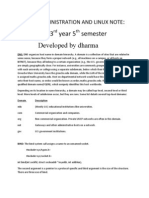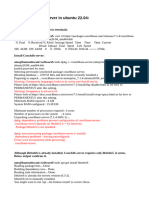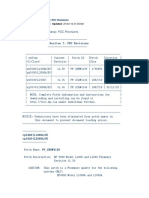0 ratings0% found this document useful (0 votes)
20 viewsHPUXSNMP0
HPUXSNMP0
Uploaded by
liuylThis document discusses configuration of the HP OpenView Agent for HP-UX and Solaris. It describes:
1) The configuration file that controls agent parameters is typically located at /etc/SnmpAgent.d/snmpd.conf or /etc/snmpd.conf.
2) The simplest configuration involves editing this file to set readable "community names" for get requests and writable names for set requests.
3) More advanced configuration allows defining multiple community names with different access levels and restricting access to parts of the managed information base (MIB).
Copyright:
© All Rights Reserved
Available Formats
Download as DOC, PDF, TXT or read online from Scribd
HPUXSNMP0
HPUXSNMP0
Uploaded by
liuyl0 ratings0% found this document useful (0 votes)
20 views2 pagesThis document discusses configuration of the HP OpenView Agent for HP-UX and Solaris. It describes:
1) The configuration file that controls agent parameters is typically located at /etc/SnmpAgent.d/snmpd.conf or /etc/snmpd.conf.
2) The simplest configuration involves editing this file to set readable "community names" for get requests and writable names for set requests.
3) More advanced configuration allows defining multiple community names with different access levels and restricting access to parts of the managed information base (MIB).
Original Description:
HPUXSNMP0
Copyright
© © All Rights Reserved
Available Formats
DOC, PDF, TXT or read online from Scribd
Share this document
Did you find this document useful?
Is this content inappropriate?
This document discusses configuration of the HP OpenView Agent for HP-UX and Solaris. It describes:
1) The configuration file that controls agent parameters is typically located at /etc/SnmpAgent.d/snmpd.conf or /etc/snmpd.conf.
2) The simplest configuration involves editing this file to set readable "community names" for get requests and writable names for set requests.
3) More advanced configuration allows defining multiple community names with different access levels and restricting access to parts of the managed information base (MIB).
Copyright:
© All Rights Reserved
Available Formats
Download as DOC, PDF, TXT or read online from Scribd
Download as doc, pdf, or txt
0 ratings0% found this document useful (0 votes)
20 views2 pagesHPUXSNMP0
HPUXSNMP0
Uploaded by
liuylThis document discusses configuration of the HP OpenView Agent for HP-UX and Solaris. It describes:
1) The configuration file that controls agent parameters is typically located at /etc/SnmpAgent.d/snmpd.conf or /etc/snmpd.conf.
2) The simplest configuration involves editing this file to set readable "community names" for get requests and writable names for set requests.
3) More advanced configuration allows defining multiple community names with different access levels and restricting access to parts of the managed information base (MIB).
Copyright:
© All Rights Reserved
Available Formats
Download as DOC, PDF, TXT or read online from Scribd
Download as doc, pdf, or txt
You are on page 1of 2
7.3.3.
HP OpenView Agent for HP-UX and Solaris
One text-configuration file controls the parameters for this agent; the file is
typically named /etc/SnmpAgent.d/snmpd.conf, or /etc/snmpd.conf on older
systems. You don't need to edit this file for the agent to function normally.
If you do edit it, you must stop and restart the master agent by executing the
SnmpMaster script, first with a stop and then a start :
$ /sbin/init.d/SnmpMaster stop
$ /sbin/init.d/SnmpMaster start
7.3.3.1. Simple configuration
The following configuration file configures the agent to respond to get
requests using the community name public and set requests using the community
name private. There are no restrictions on which MIBs can be queried, or which
hosts can make the queries. This configuration has no security, since the
community strings are set to commonly used defaults and are widely known. The
OpenView agent sends authentication-failure traps by default, so you don't have
to enable these traps in the configuration file.
get-community-name: public
set-community-name: private
trap-dest: 127.0.0.1
contact: B.Gates
location: 12 Pyramid - Egypt
The simplest configuration is to edit the file and place more reasonable
community names in the first two lines. We can't say it too much: community
names are essentially passwords. Use the same rules for picking community names
that you would for choosing the root password. You should always set the
destination trap host (trap-dest) to the IP address of the host that will
receive the trap.
The next example configures several different community names:
get-community-name: public
get-community-name: media
set-community-name: hushed
set-community-name: veryprivate
set-community-name: shhhh
We have created two get (read-only) communities and three set (read-write)
communities. These communities can be used as you see fit. (In real life, we
would have chosen more obscure names.) For example, you might give your
operations group in New York public community access and your operations group
in Atlanta media community access. The remaining set communities can further be
subdivided among various administrators and other staff who need read-write
access.
7.3.3.2. Advanced configuration
Setting up multiple community strings doesn't sound very useful, and by itself,
it isn't. But you can take the concept a step further and create different
communities, each of which consists of a few particular hosts and can access
only some of the objects SNMP manages. The next example allows the host
10.123.56.25 to issue gets using the community name comname and sets using the
community name private. The host 10.123.46.101 can issue gets using only the
community name comname. You cannot use hostnames after the IP: directive; you
must use IP addresses.
get-community-name comname IP: 10.123.56.25 10.123.46.101
set-community-name private IP: 10.123.56.25
You can also configure the agent to restrict access to MIB subtrees based on IP
addresses. The next example allows any host to get any object under
iso.org.dod.internet.mgmt.mib-2, except for objects in the interfaces subtree.
The minus sign (-) in front of interfaces instructs the agent to disallow
access to this subtree.
get-community-name public VIEW: mib-2 -interfaces
The final example sets up multiple community names for both sets and gets. An
administrator who is located at host 10.123.46.25 and knows the admin community
string has read access to the entire MIB tree; with the adminset community
string, he has write access to the entire tree. Someone with the operator
community string can sit anywhere and access everything in mib-2 except for the
interfaces subtree, but must be sitting at his desk (10.123.56.101) to issue
sets and is not allowed to set anything in the mib-2 subtree.
get-community-name operator VIEW: mib-2 -interfaces
get-community-name admin IP: 10.123.56.25
set-community-name operset IP: 10.123.46.101 VIEW: -mib-2
set-community-name adminset IP: 10.123.56.25
You might also like
- EX200 Fast Track Exam PrepDocument17 pagesEX200 Fast Track Exam PrepAtish DipankarNo ratings yet
- Creating A Company Culture For Security-Design DocumentsDocument2 pagesCreating A Company Culture For Security-Design DocumentsOnyebuchiNo ratings yet
- Sun Certified System Administrator Examination For Solaris 9 Study Guide Exam 310-011Document845 pagesSun Certified System Administrator Examination For Solaris 9 Study Guide Exam 310-011massimo.perfettoNo ratings yet
- CISSP My - Nots PDFDocument11 pagesCISSP My - Nots PDFMarc Anthony N100% (1)
- 深入浅出oracle ebs之核心功能(mfg)Document93 pages深入浅出oracle ebs之核心功能(mfg)latest shiNo ratings yet
- RhceDocument8 pagesRhceNadeem AliNo ratings yet
- Sudo UsersDocument8 pagesSudo UsersParveshi PusunNo ratings yet
- SNA Final Trem NotesDocument23 pagesSNA Final Trem Noteshushamgillani22No ratings yet
- Linux Useradd CommandDocument33 pagesLinux Useradd CommandVijay ShuklaNo ratings yet
- Windows Admin L2Document32 pagesWindows Admin L2ranampcNo ratings yet
- Step by Step Linux GuideDocument396 pagesStep by Step Linux GuideRahul100% (24)
- Chapter 16Document21 pagesChapter 16Sai Vamsi GandhamNo ratings yet
- Part A - V7 Exam Questions: 1. Configure SELINUXDocument43 pagesPart A - V7 Exam Questions: 1. Configure SELINUXAhmed Abdelfattah50% (4)
- Linux QuestionsDocument11 pagesLinux QuestionsMurali TungaNo ratings yet
- Configuration of a Simple Samba File Server, Quota and Schedule BackupFrom EverandConfiguration of a Simple Samba File Server, Quota and Schedule BackupNo ratings yet
- Active Directory: FMSO RolesDocument10 pagesActive Directory: FMSO RolesShibhijith AyilalathNo ratings yet
- RHCE 6 ExamDocument16 pagesRHCE 6 ExamBahram K.No ratings yet
- Linux 4Document20 pagesLinux 4michal hanaNo ratings yet
- Samba Configuration in CentosDocument7 pagesSamba Configuration in Centossmith858No ratings yet
- Load Balancing Interview QuestionsDocument18 pagesLoad Balancing Interview QuestionsPhillipNo ratings yet
- Windows Post-Exploitation Command ListDocument15 pagesWindows Post-Exploitation Command ListAndres MirandaNo ratings yet
- RHCSADocument7 pagesRHCSADesapimal BetoNo ratings yet
- CyberAces Module1-Windows 5 UsersAndGroupsDocument25 pagesCyberAces Module1-Windows 5 UsersAndGroupsAbiodun AmusatNo ratings yet
- Configuration of a Simple Samba File Server, Quota and Schedule BackupFrom EverandConfiguration of a Simple Samba File Server, Quota and Schedule BackupNo ratings yet
- Linux 5th Sem EvrDocument17 pagesLinux 5th Sem EvrTirthankar Roy ChowdhuryNo ratings yet
- Audit Windows ServerDocument19 pagesAudit Windows Servereinskhin1024No ratings yet
- RHCSA9 New DemoDocument11 pagesRHCSA9 New Demor886vco6zNo ratings yet
- Attractive Directory Report THMDocument15 pagesAttractive Directory Report THMsakitazeyekNo ratings yet
- Linux Interview QuestionsDocument52 pagesLinux Interview Questionsvinnuthegreat100% (1)
- Linux Tricky QuestionsDocument21 pagesLinux Tricky QuestionssrisomsNo ratings yet
- Tutorial Configure Samba ServerDocument10 pagesTutorial Configure Samba ServerSYED AHMAD SHAUQI BIN SYED SHUHAIMI100% (1)
- Rhce Question and AnswerDocument27 pagesRhce Question and AnswerRaj ShuklaNo ratings yet
- RHCSADocument13 pagesRHCSASyed Fahad AliNo ratings yet
- LinuxDocument397 pagesLinuxPrakash R ChetryNo ratings yet
- Linux Commands To Manage Local AccountsDocument25 pagesLinux Commands To Manage Local AccountsgshreyaNo ratings yet
- User/Groups Administration: Username. Password FlagDocument18 pagesUser/Groups Administration: Username. Password Flagkrishan_ydsapNo ratings yet
- Centos 7 / Rhel 7: Install and Setup Samba Server (File Sharing)Document7 pagesCentos 7 / Rhel 7: Install and Setup Samba Server (File Sharing)info infoNo ratings yet
- Install CouchDB Server in Ubuntu 22.04Document13 pagesInstall CouchDB Server in Ubuntu 22.04Velan ChandrasekarNo ratings yet
- LAB_ExploitationDocument16 pagesLAB_Exploitationssr2086No ratings yet
- CH01Document21 pagesCH01Felix GatambiaNo ratings yet
- Linux System Administrator Interview Questions You'll Most Likely Be AskedFrom EverandLinux System Administrator Interview Questions You'll Most Likely Be AskedNo ratings yet
- Wireless and Mobile Hacking and Sniffing TechniquesFrom EverandWireless and Mobile Hacking and Sniffing TechniquesNo ratings yet
- Group Policy: Fundamentals, Security, and the Managed DesktopFrom EverandGroup Policy: Fundamentals, Security, and the Managed DesktopNo ratings yet
- How Cybersecurity Really Works: A Hands-On Guide for Total BeginnersFrom EverandHow Cybersecurity Really Works: A Hands-On Guide for Total BeginnersNo ratings yet
- Footprinting, Reconnaissance, Scanning and Enumeration Techniques of Computer NetworksFrom EverandFootprinting, Reconnaissance, Scanning and Enumeration Techniques of Computer NetworksNo ratings yet
- Ultimate Hacking Challenge: Hacking the Planet, #3From EverandUltimate Hacking Challenge: Hacking the Planet, #3Rating: 5 out of 5 stars5/5 (2)
- Protecting Confidential Information: How to Securely Store Sensitive DataFrom EverandProtecting Confidential Information: How to Securely Store Sensitive DataNo ratings yet
- Hacking of Computer Networks: Full Course on Hacking of Computer NetworksFrom EverandHacking of Computer Networks: Full Course on Hacking of Computer NetworksNo ratings yet
- Become An Ethical Hacker That Can Hack Computer Systems And Secure Them Like Security ExpertsFrom EverandBecome An Ethical Hacker That Can Hack Computer Systems And Secure Them Like Security ExpertsNo ratings yet
- Common Windows, Linux and Web Server Systems Hacking TechniquesFrom EverandCommon Windows, Linux and Web Server Systems Hacking TechniquesNo ratings yet
- Evaluation of Some Intrusion Detection and Vulnerability Assessment ToolsFrom EverandEvaluation of Some Intrusion Detection and Vulnerability Assessment ToolsNo ratings yet
- Overview of Some Windows and Linux Intrusion Detection ToolsFrom EverandOverview of Some Windows and Linux Intrusion Detection ToolsNo ratings yet
- Evaluation of Some Windows and Linux Intrusion Detection ToolsFrom EverandEvaluation of Some Windows and Linux Intrusion Detection ToolsNo ratings yet
- HP-UX PVID TDocument11 pagesHP-UX PVID TliuylNo ratings yet
- NBU Snapshot 1Document2 pagesNBU Snapshot 1liuylNo ratings yet
- EMC-CX Tips 2Document3 pagesEMC-CX Tips 2liuylNo ratings yet
- IBM P FW 2Document6 pagesIBM P FW 2liuylNo ratings yet
- AIX Fcs KDBDocument8 pagesAIX Fcs KDBliuylNo ratings yet
- Nbu Faq 3Document12 pagesNbu Faq 3liuylNo ratings yet
- VXDMP CorruptDocument5 pagesVXDMP CorruptliuylNo ratings yet
- HP-UX Login AccountDocument4 pagesHP-UX Login AccountliuylNo ratings yet
- Aix VioDocument8 pagesAix VioliuylNo ratings yet
- Aix Wpar 2Document13 pagesAix Wpar 2liuylNo ratings yet
- Docid: Lckbca00001025 Updated: 2/1/02 10:21:00 Am: Hp9000 Rp54Xx (L-Class) : PDC RevisionsDocument7 pagesDocid: Lckbca00001025 Updated: 2/1/02 10:21:00 Am: Hp9000 Rp54Xx (L-Class) : PDC RevisionsliuylNo ratings yet
- Online JfsDocument3 pagesOnline JfsliuylNo ratings yet
- Sfora Odm 1Document5 pagesSfora Odm 1liuylNo ratings yet
- Oracle 10g RecommendationsDocument21 pagesOracle 10g RecommendationsliuylNo ratings yet
- LPMC Type: D-Cache Parity ErrorDocument2 pagesLPMC Type: D-Cache Parity ErrorliuylNo ratings yet
- Problem: Phase 1 - Checking System Requirements For New NodeDocument9 pagesProblem: Phase 1 - Checking System Requirements For New NodeliuylNo ratings yet
- Program MemstreamDocument7 pagesProgram MemstreamliuylNo ratings yet
- Log 09Document5 pagesLog 09Giorgi BubashviliNo ratings yet
- AstroDocument4 pagesAstroR PNo ratings yet
- Splunk 7.X Fundamentals Part 2 (IOD)Document281 pagesSplunk 7.X Fundamentals Part 2 (IOD)Kaushal100% (5)
- ABAP OO Explained With ExampleDocument10 pagesABAP OO Explained With ExampleRam PraneethNo ratings yet
- Assignment 1 Based On Unit 1Document6 pagesAssignment 1 Based On Unit 1Anu stephie NadarNo ratings yet
- A Step-By-Step Walkthrough of SQL Inner JoinDocument9 pagesA Step-By-Step Walkthrough of SQL Inner JoinkklakkNo ratings yet
- A Single PPT On ERP Systems - Used in Class For MBA 12-14Document182 pagesA Single PPT On ERP Systems - Used in Class For MBA 12-14nanaiahbnNo ratings yet
- Killdisk ScriptingDocument21 pagesKilldisk Scriptingiann opNo ratings yet
- Gap Analysis Template - ExcelDocument2 pagesGap Analysis Template - ExcelNagul MeeraNo ratings yet
- Advanced Networking Best Practices With Azure ExpressRouteDocument36 pagesAdvanced Networking Best Practices With Azure ExpressRoutetarunsood2009No ratings yet
- MainDocument22 pagesMainindah sariNo ratings yet
- Apache FlinkDocument116 pagesApache FlinkAylin KorogluNo ratings yet
- JNTUA-R20-B.Tech - .-Civil-Engineering-III-IV-Year-syllabus (1) - RemovedDocument2 pagesJNTUA-R20-B.Tech - .-Civil-Engineering-III-IV-Year-syllabus (1) - RemovedSiva NallabothulaNo ratings yet
- DataBase Normalization All NFDocument23 pagesDataBase Normalization All NFNiqtab RashidNo ratings yet
- Serverless Coumputing ProjectDocument8 pagesServerless Coumputing Projectjohn claireNo ratings yet
- User Manual: ICS 6200 Call Logging InterfaceDocument17 pagesUser Manual: ICS 6200 Call Logging InterfaceGilberto Lopez AvalosNo ratings yet
- Iot Answer 1-3Document3 pagesIot Answer 1-3MA. CHARMIA SAMATRANo ratings yet
- Perform DB System Test ExamDocument2 pagesPerform DB System Test ExamBeede AshebirNo ratings yet
- NPTEL Week 7Document4 pagesNPTEL Week 7Dippal IsraniNo ratings yet
- Object Oriented Analysis and DesignDocument7 pagesObject Oriented Analysis and DesigndeepasceNo ratings yet
- Life As A Software EngineerDocument19 pagesLife As A Software EngineerDriegataNo ratings yet
- Ead MCQSDocument25 pagesEad MCQSMuhammad AbdullahNo ratings yet
- CV - Jeremiah Paul OcampoDocument2 pagesCV - Jeremiah Paul Ocampojp ocampoNo ratings yet
- Windows - AirsnortDocument3 pagesWindows - AirsnortMark Antony CoorayNo ratings yet
- Process ListdfdsssdfDocument11 pagesProcess ListdfdsssdfAnonymous BJdOLuABNo ratings yet
- Normalization Part 2Document6 pagesNormalization Part 2Urja DhabardeNo ratings yet
- REPORTDocument13 pagesREPORTNguyễn Trung AnhNo ratings yet










































































































